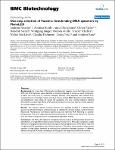One-step selection of Vaccinia virus-binding DNA aptamers by MonoLEX
Nitsche, Andreas
Kurth, Andreas
Dunkhorst, Anna
Pänke, Oliver
Sielaff, Hendrik
Junge, Wolfgang
Muth, Doreen
Scheller, Frieder
Stöcklein, Walter
Dahmen, Claudia
Pauli, Georg
Kage, Andreas
Background: As a new class of therapeutic and diagnostic reagents, more than fifteen years ago RNA and DNA aptamers were identified as binding molecules to numerous small compounds, proteins and rarely even to complete pathogen particles. Most aptamers were isolated from complex libraries of synthetic nucleic acids by a process termed SELEX based on several selection and amplification steps. Here we report the application of a new one-step selection method (MonoLEX) to acquire high-affinity DNA aptamers binding Vaccinia virus used as a model organism for complex target structures. Results: The selection against complete Vaccinia virus particles resulted in a 64-base DNA aptamer specifically binding to orthopoxviruses as validated by dot blot analysis, Surface Plasmon Resonance, Fluorescence Correlation Spectroscopy and real-time PCR, following an aptamer blotting assay. The same oligonucleotide showed the ability to inhibit in vitro infection of Vaccinia virus and other orthopoxviruses in a concentration-dependent manner. Conclusion: The MonoLEX method is a straightforward procedure as demonstrated here for the identification of a high-affinity DNA aptamer binding Vaccinia virus. MonoLEX comprises a single affinity chromatography step, followed by subsequent physical segmentation of the affinity resin and a single final PCR amplification step of bound aptamers. Therefore, this procedure improves the selection of high affinity aptamers by reducing the competition between aptamers of different affinities during the PCR step, indicating an advantage for the single-round MonoLEX method.
No license information

